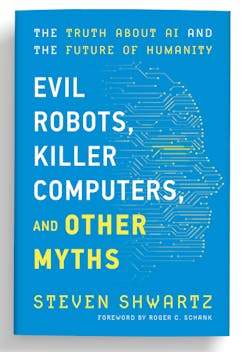Steve Shwartz
Many people are worried about artificial intelligence taking over the world. A recent study found that 60% of the people in the UK fear AI. Tesla founder Elon Musk says that AI is humanity’s “biggest existential threat,” and that it poses a “fundamental risk to the existence of civilization.”
Let’s look at four myths about AI in industry…
Myth 1: Robots will replace most human workers. Once AI advances to the point of human-level intelligence, robots will be able to read manuals, take classes, and learn to do all our jobs.
Myth 2: AI-based viruses will decimate our IT infrastructures.
Myth 3: Vehicle manufacturers will stop making steering wheels. They will no longer be needed once cars, trucks, and buses have full self-driving capabilities.
Myth 4: Defense manufacturers will soon develop Terminator-like killer robots.
The reality
Each of these myths assumes researchers will figure out how to imbue computers that can think and reason like people. Given the recent progress in AI, it is natural to assume that human-level AI systems cannot be too far down the road. After all, we now have computers that can recognize our faces, translate languages, and beat the top Jeopardy! players in the world.
Fortunately, despite the astounding progress in AI, computers and robots that can think and reason like people exist only in science fiction. Today’s AI systems can only learn to perform a single task and the AI technologies underlying today’s incredible AI systems cannot be extended to produce thinking and reasoning systems. See this blog post for a more in-depth explanation.
Jobs
Robots will not become smart enough to learn jobs by reading books and taking classes.
AI technology will certainly be responsible for some job loss. However, conventional (non-AI) software has been responsible for far more job loss than AI software and this trend will likely continue. E-commerce is devastating brick-and-mortar stores, but uses conventional software, not AI. Conventional rideshare software like Uber and Lyft is displacing taxi drivers. The robots that take jobs in factories and warehouses use a sixty-year-old conventional software technique known as dynamic programming.
Robert Gordon, professor of social sciences at Northwestern University, said that, in the 250 years since the first industrial revolution, there has never been a technology that caused mass unemployment, and there is no reason to believe AI will change this pattern.
Cybersecurity
We don’t have to worry about thinking viruses. Neither researchers nor hackers have a clue how to build such a thing.
AI will likely have more of a positive impact on cybersecurity than a negative impact. The ability to use AI to defend against novel malware is essential to defenders. This is balanced against the ability for attackers to create novel malware using AI and the larger attack surface created by AI applications.
Self-driving cars and trucks
AI enables self-driving vehicles to “see.” Today’s self-driving cars use individual machine-learning systems to detect pedestrians, to identify lane markers, and much more. However, the “brain” of today’s self-driving vehicles is still primarily conventional programming.
Steve Shwartz's upcoming book
People use commonsense reasoning to handle unexpected phenomena while driving: a deer darts onto the highway or a flood makes the road difficult or impossible to navigate.
Self-driving vehicles have no commonsense reasoning capabilities and may never have them. It is therefore incumbent on self-driving vehicle manufacturers to identify all possible edge cases and develop software for each edge case. This is likely not possible for consumer vehicles.
Because of edge cases, consumer vehicles will probably need steering wheels for the foreseeable future so that drivers can take over when an edge case presents itself. At the other end of the spectrum, we are starting to see slow-moving shuttles (lacking drivers and steering wheels) that simply shuttle people between two points on a corporate campus. However, edge cases will likely limit vehicles without steering wheels to a relatively small proportion on the road for the foreseeable future.
Autonomous weapons
The fearsome Terminator robot is not in our future because we have no clue how to build computer or robots that can think and reason.
Unmanned aerial vehicles without AI have been used in warfare since the US began to deploy them after the 9/11 attacks. These non-AI UAVs include drones and missiles that are either controlled remotely by operators at consoles or that find targets using radar, geographic coordinates, or heat-seeking capabilities. AI technology enables slightly more UAV autonomy by also enabling visual identification of targets.
Conclusions
The sudden success of AI technology leads many people to assume that the intelligent robots of science fiction lore are right around the corner. They are not. However, AI is having a big impact on industry. To understand the impact, it is critical to first separate the fiction from the reality.
Steve Shwartz is a serial software entrepreneur, investor and author. His new book, “Evil Robots, Killer Computers, and Other Myths: The Truth About AI and the Future of Humanity,” will be available February 9, 2021. Learn more about Steve here.





